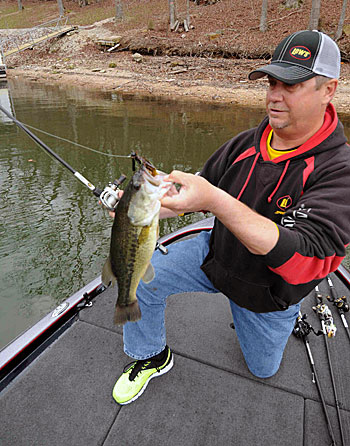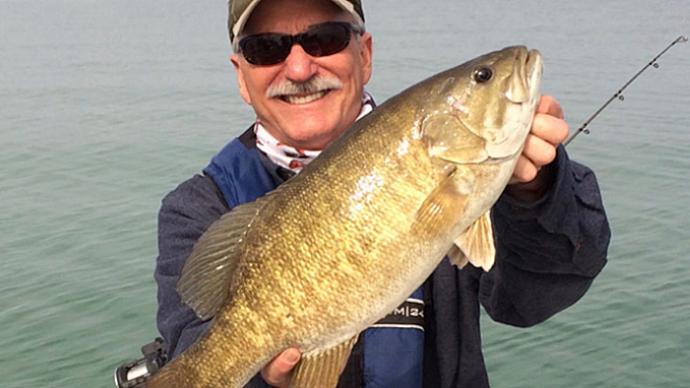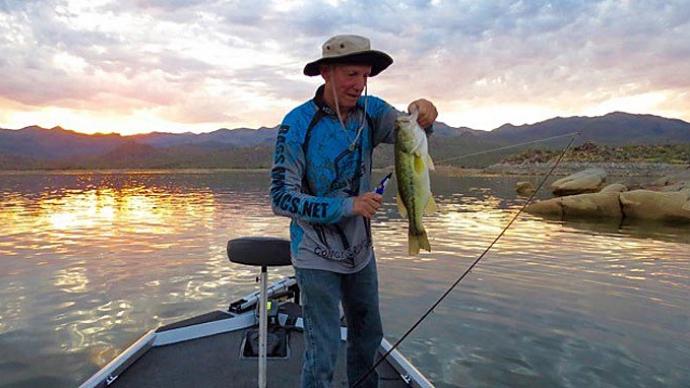
Standard casting or flipping jigs have always been associated with power fishing tactics. Still, a smaller and lighter version of the lure has become an effective alternative when bass get picky.
Former Bass Fishing League (BFL) All-American champion Brian Maloney has become an advocate of the finesse jig and religiously uses it in the same situations other anglers would rely on standard flipping or casting jigs. “It’s smaller, but more importantly, the lighter the jig, the more erratic the fall is,” Maloney says. Sometimes the jig will spiral on you, and sometimes it will shoot away from you. But you must be extremely careful to go with light line to get that action out of those jigs.”
Finesse jigs were initially designed with a collared skirt and a ball head. The collared skirt is still a trademark of a finesse jig, but lure manufacturers are now making versions with a swim, rocker, and football heads. The jig is also equipped with a light wire hook, which Maloney believes penetrates deeper than heavier gauge hooks for a better hookset. He cautions that the light wire hook will bend on a hookset if you are using heavy line, so downscale to lighter line and loosen your reel’s drag so it will slightly give up some line during a hookset.
The Missouri angler relies on Jakked Baits Finesse Jigs, which feature multi-color skirts. His favorite jig colors include black and blue with a dash of purple or chartreuse, green pumpkin or black and brown mixed with a shade of red or chartreuse.
The tournament veteran opts for 5/16- or 7/16-ounce finesse jigs for most of his pitching applications. However, in “super clear” water, he will switch to a 1/4-ounce model that he throws with spinning gear.
Matching the finesse jig with the right size trailer is crucial. Maloney’s favorite soft plastic trailers include a bulky flipping tube and a 4-inch Strike King Rage Bug. He avoids tipping the jig with larger trailers, which would dominate the jig.
“You have to be careful when you start pushing up 4-inch or bigger trailers because it can dominate that little jig and take action out of it,” he says. “If those tails on the trailer are too big, you might as well throw just the trailer and not even have a jig on there.”
Maloney always tries to contrast the colors of his jig and trailer. He experiments with different color combinations, such as a black/blue jig with a smoke trailer or a black/blue jig with a green pumpkin trailer.

His finesse jig tackle includes a 7-foot, 11-inch Lew’s Custom Lite Speed Stick (extra-heavy action and medium-fast power) and a Lew’s Team Pro SP Speed Spool 8.3:1 baitcast reel filled with 12-pound Seaguar InvizX Fluorocarbon. Maloney scales down to 10-pound fluorocarbon when fishing in clear water and opts for 14-pound fluorocarbon for dirty water fishing. Maloney claims the most significant mistake some anglers make is tying finesse jigs on 15- to 20-pound line because the heavier line kills the jig’s action.
The finesse jig has been produced for Maloney in all ranges of water color. “I have fished it from the clear waters of Table Rock to the dirty, muddy Tennessee-Tombigbee river system, so it doesn’t matter,” he says. “It resembles a small crawfish or baitfish, so I am not worried about the color of the water.”
Maloney also likes to pitch the jig in the same cover as others probe with bigger jigs. He pitches it into the bushes, swims it along the sides of docks or laydowns, skips it under docks to big bass sitting in the shade, or casts it along bluffs or rocky banks. “It’s a finesse jig, but it is still a jig, so anything you can fish with a 1/2- or 3/4-ounce you can do with the little jig,” he says. “It is a very versatile bait. I think a lot of people overlook it because they are so wrapped up in the heavier baits, and they want to be able to feel those baits.”
The finesse jig is especially effective for Maloney when he targets lethargic bass that want a slower falling lure. “It is a different presentation in that you just have to slow down and lighten up on your line,” he says. “The one factor of the small jigs that people don’t like is that they have to fish them so slow to keep the feel.”
The two-time B.A.S.S. Nation Championship qualifier mainly fishes the finesse jig in shallow water, but he will present it to bass out to depths of 20 feet if he knows the fish are that deep. Maloney suggests the finesse jig is a hard lure to search for bass because it has to be fished slowly, especially in water deeper than 12 feet.
His finesse jig retrieve varies depending on the mood of the fish. Sometimes he swims the jig 1 to 2 feet off the bottom or hops it along the bottom. For inactive bass, he deadsticks the jig, letting it sit on the bottom for about five seconds or longer.
Maloney relies on his jig in all sorts of weather and all seasons. “It’s a 365-day-a-year jig,” he says.
BassResource may receive a portion of revenues if you make a purchase using a link above.




